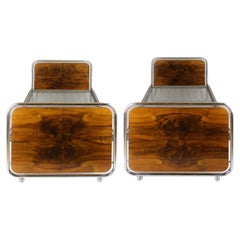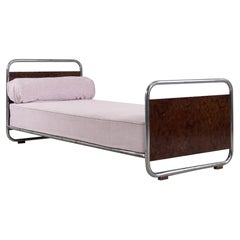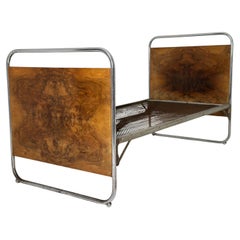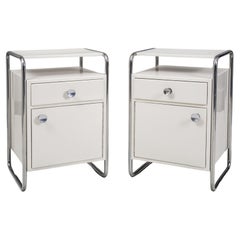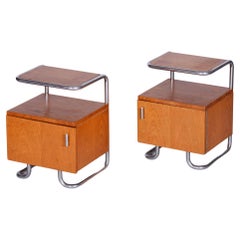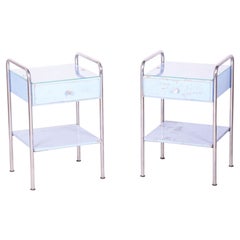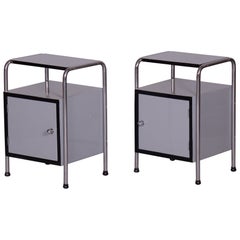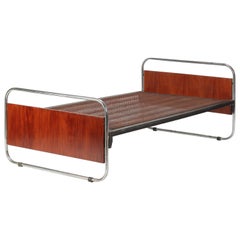Bauhaus Bed Chrome
Mid-20th Century Bauhaus Beds and Bed Frames
Steel, Chrome
Vintage 1920s Unknown Bauhaus Beds and Bed Frames
Chrome
Vintage 1920s Austrian Bauhaus Beds and Bed Frames
Chrome, Wire
Vintage 1940s German Bauhaus Armchairs
Metal, Iron, Chrome
Vintage 1930s Czech Bauhaus Side Tables
Steel, Chrome
Vintage 1930s Czech Bauhaus Sofas
Steel, Chrome
Vintage 1930s Czech Bauhaus Sofas
Metal, Steel, Chrome
Vintage 1930s Czech Bauhaus Sofas
Steel, Chrome
Recent Sales
Vintage 1930s Czech Mid-Century Modern Beds and Bed Frames
Chrome
Vintage 1930s Czech Bauhaus Daybeds
Steel, Chrome
Vintage 1930s German Bauhaus Beds and Bed Frames
Chrome
Mid-20th Century Bauhaus Beds and Bed Frames
Chrome, Steel
Mid-20th Century Bauhaus Beds and Bed Frames
Steel, Chrome
Mid-20th Century Bauhaus Beds and Bed Frames
Steel, Chrome
Vintage 1930s Czech Bauhaus Daybeds
Chrome
Vintage 1940s Czech Bauhaus Armchairs
Steel, Chrome
Mid-20th Century Czech Bauhaus Side Tables
Chrome
Mid-20th Century Bauhaus Bedroom Sets
Steel, Chrome
Early 20th Century Czech Bauhaus Side Tables
Chrome
Vintage 1930s Czech Bauhaus Side Tables
Chrome
Early 20th Century Czech Bauhaus Side Tables
Chrome
20th Century Czech Bauhaus Side Tables
Chrome
Vintage 1930s Czech Bauhaus Armchairs
Chrome
Vintage 1930s Czech Bauhaus Beds and Bed Frames
Chrome
Vintage 1940s Bauhaus Bedroom Sets
Steel, Chrome
Vintage 1930s German Bauhaus Side Tables
Chrome
Vintage 1930s Czech Bauhaus More Mirrors
Steel, Chrome
Vintage 1930s Czech Bauhaus Side Tables
Steel, Chrome
Vintage 1930s Czech Bauhaus Daybeds
Chrome
Vintage 1930s German Bauhaus Armchairs
Metal, Aluminum, Iron, Chrome
Early 20th Century Czech Bauhaus Side Tables
Chrome
Vintage 1930s Czech Bauhaus Side Tables
Chrome
Early 20th Century Czech Bauhaus Side Tables
Chrome
20th Century Czech Bauhaus Side Tables
Chrome
20th Century Czech Bauhaus Side Tables
Chrome
Vintage 1930s Czech Bauhaus Side Tables
Steel, Chrome
Mid-20th Century Czech Bauhaus Beds and Bed Frames
Steel, Chrome
Vintage 1930s Czech Bauhaus Sofas
Chrome
People Also Browsed
21st Century and Contemporary Belgian Side Tables
Sandstone
Vintage 1970s Italian Post-Modern Beds and Bed Frames
Leather, Wood
Vintage 1930s French Art Deco Desks and Writing Tables
Mahogany
Vintage 1950s Italian Mid-Century Modern Dry Bars
Brass
Vintage 1950s Italian Mid-Century Modern Beds and Bed Frames
Walnut, Birch
2010s British Scandinavian Modern Tables
Mohair, Oak
21st Century and Contemporary European Neoclassical Benches
Iron
2010s Oceanic Organic Modern Ottomans and Poufs
Fabric, Foam
21st Century and Contemporary Mexican Mid-Century Modern Table Lamps
Wood, Fabric, Linen, Fiberglass
21st Century and Contemporary American Mid-Century Modern Wall Lights an...
Enamel, Brass
2010s Italian Mid-Century Modern Table Lamps
Brass
Vintage 1940s Italian Art Deco Beds and Bed Frames
Wood, Burl
Vintage 1950s French Mid-Century Modern Daybeds
Metal
Vintage 1950s Italian Mid-Century Modern Beds and Bed Frames
Metal
Vintage 1970s Italian Coffee and Cocktail Tables
Walnut
Vintage 1930s French Art Deco Beds and Bed Frames
Wood
Bauhaus Bed Chrome For Sale on 1stDibs
How Much is a Bauhaus Bed Chrome?
Read More
The Creative Genius of Bauhaus Master Herbert Bayer Knew No Boundaries
An exhibition at Manhattan's Cooper Hewitt Smithsonian Design Museum shows the German artistic polymath in a new light.
How Chicago, Mies van der Rohe’s Adopted Home, Remembers the Architect
The Windy City's Matthew Rachman Gallery takes a deep dive into the designer's practice.
William Monaghan’s Industrial Canvases Speak of a Lost America
The New Orleans–based artist possesses the increasingly rare skills of a highly trained artisan and the eye of an experienced scavenger, as is evident in a new museum exhibition and in his own Crescent City home.
